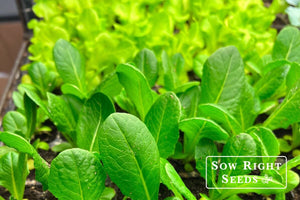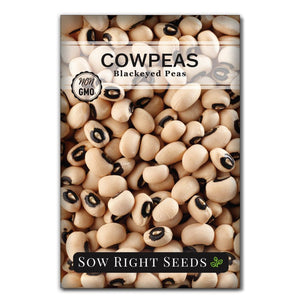Your First Time Growing Edamame? These Tips Guarantee Tasty Success
Looking to grow your own edamame? This delicious, protein-rich snack is easy to grow from seed. One of the fun things about a home garden is growing things that are expensive or hard to find at your local store. If you’ve ever had warm edamame perfectly cooked and fresh, you know what I’m talking about. Such a simple dish and yet so expensive. You don’t have to go to a specialty store or buy an overpriced appetizer. You can grow this healthy vegetable in your own garden, even in containers.

The first time I had edamame in a restaurant, I was a little suspicious of those fuzzy green pods. But once I learned how to eat the beans out of the pod, I was sold. Edamame has an earthy, fresh taste, and they’re easy to grow. Sure, you could buy frozen edamame, but as we often say at Sow Right Seeds, everything tastes so much better when it’s picked fresh out of the garden and eaten the same day.
Chiba Green Soybean (Glycine max) is perfect for picking fresh as edamame. This heirloom, non-GMO variety produces a reliable crop of pods that usually bear three plump seeds. The plants are compact, easy to harvest, and perfect for small gardens.
What Is Edamame?
Edamame refers to immature green soybeans that are harvested before they fully ripen. Unlike mature soybeans, which are dried and processed into foods like tofu, tempeh, soy sauce, and soy milk, edamame is enjoyed fresh. It's usually steamed or boiled right in the pod.
Although soybeans have been cultivated for thousands of years, the first documented mention of edamame was in Japan in 1275. In recent decades, edamame has gained popularity in the United States as a healthy snack and appetizer.
What makes edamame special—besides its fresh, earthy flavor—is its impressive nutritional profile. These little green beans are a complete protein, containing all nine essential amino acids. A half-cup of boiled edamame has about 11 grams of protein and 16 mg of isoflavones, plus fiber, folate, potassium, and omega-3 fatty acids. [Source: Straight Talk About Soy]
Most soybeans grown in the U.S. are used for animal feed, with 97% of soybean meal going to livestock. [Source: Soy Bean Uses] Growing your own edamame at home lets you enjoy the health benefits of soy—without the processing or the GMO concerns.
At Sow Right Seeds, we offer heirloom, non-GMO edamame seeds so you can grow delicious soybeans the natural way. Edamame is easy to grow, perfect for home gardens or containers, and a great addition to your garden if you’re looking for fresh, plant-based protein.

How to Grow Edamame from Seed
The plants themselves don’t get that big and can be grown in raised beds and containers. It is best to direct sow bean plants. Succession sow seeds every 3 or 4 weeks so that you have a continual harvest.
If you start edamame seeds indoors, be very gentle with transplanting to avoid disturbing the root system.

Seed Germination Tips
Edamame plants are easy to grow from seed. You don't need special germination tips other than these:
You want warm soil - 65-75ºF. Cold, wet soil can result in seeds that rot instead of sprout.
Space seeds 4-6 inches apart and plant 1 inch deep.
Seeds will germinate in 10 to 14 days.

Growing Edamame Plants
Edamame plants will appreciate sunshine and warm temperatures. The plants will grow 12-16 inches wide and 1-3 feet high.
When growing heirloom edamame, you can let some pods stay on the plant until they fully mature and dry. These dry seeds can be planted in the next growing season.
Sun
Plant edamame in full sun. The plants will need a minimum of 6 hours of direct sunlight daily. Less sunlight will result in less bean production.
Soil
From the time you plant the seeds until harvest, edamame needs warm soil that drains well. The optimal soil pH is 6 to 6.5.
Water
Give plants enough water so that they continue setting blossoms. Soil should be damp 1 to 2 inches deep, but not overly wet, as this can lead to root rot.
Fertilizer
Test your soil, as you may not need additional fertilizer if you have nutrient-rich soil. Edamame plants can fix nitrogen, so if you do apply any fertilizer, use one that is low in nitrogen.
Harvesting Edamame
Edamame is ready to harvest about 75 to 90 days after planting, depending on your growing conditions and variety. The key is to pick the pods when the beans are fully formed but still green and tender.
Look for bright green, slightly fuzzy pods where the beans inside are plump and nearly touching each other. Most pods will have three beans, though some may have only one or two. For edamame, don’t wait too long to harvest. If the pods begin to yellow or dry, the beans will lose their sweet, fresh flavor and become tougher and starchier.
To harvest, use scissors or garden snips to clip off the pods, or use both hands—one to hold the stem and the other to gently pull the pod. This prevents accidentally pulling off an entire branch, especially when the plant is still producing more pods.
If you planted in succession, be sure to check plants every couple of days during the peak harvest window. Pods tend to ripen quickly in warm weather, so regular harvesting ensures you don’t miss the sweet spot.

Edamame, like fresh peas, tastes best when eaten the same day it’s picked. My favorite way to enjoy it is to snip the stem end off the pods and boil them in salted water for 3 to 5 minutes. Drain, sprinkle with sea salt and a little butter (optional), then pop the beans out with your teeth—delicious!
If you’re not eating them right away, store freshly picked pods in the refrigerator for up to 2–3 days, or blanch and freeze them for longer storage.
When you grow heirloom edamame, you can save your seeds and plant them next season.
Soybean plants can be turned back into the soil as a source of nitrogen. For no-till gardening, cut off the plants at the soil line and add them to your compost.

Pests & Diseases to Watch For
Edamame plants are generally easygoing, but like all garden crops, they’re not immune to pests and diseases. Here are the most common issues to watch out for and how to stop them early.
Aphids
Tiny green or black insects that cluster on stems and leaves, sucking sap and weakening your plant.
What to do: Check plants frequently and use natural methods to control aphids.
Bean Beetles
Look for yellow-orange beetles with black spots or their larvae feeding on leaves.
What to do: Hand-pick beetles, use row covers or apply neem oil as needed.
Bean Rust
This fungal disease shows up as reddish-orange powdery spots on leaves. It spreads from airborne spores and thrives in warm, humid conditions.
What to do: If caught early, you can remove leaves and apply a fungicide. Avoid overhead watering.
Powdery Mildew
Look for a white, powdery coating on the leaves. When most of the leaves are covered, this can stunt plant growth.
What to do: Water at the base, avoid overhead watering, and space plants to increase airflow.
Anthracnose Blight
Dark, sunken spots on stems, leaves, or pods can spread quickly in wet conditions.
What to do: Remove infected plant materials and apply a copper-based fungicide.
Root Rot
Caused by overly wet soil and poor drainage. Root rot leads to wilted, yellow plants.
Control: Plant in well-draining soil and avoid overwatering.
Prevention Tips:
Use well-draining soil and avoid overwatering.
Water at the base of the plant to keep leaves dry.
Rotate crops each season to prevent soil-borne diseases.
Plant in full sun for strong, healthy growth.
Ensure your garden has good airflow.
Inspect plants regularly to catch problems early.
It’s always a good gardening practice to watch for pests and diseases so you can take action before your plants are destroyed. For more on how to identify and treat garden diseases, check out our complete guide here: Common Garden Diseases and How to Fight Them

Edamame FAQs
Are edamame and soybeans the same thing?
Yes. Edamame is the name for the immature green soybeans harvested before they dry out. They’re a tasty snack and are often served freshly boiled or steamed, straight from the pod.
Are edamame the same as lima beans?
Although both members of the legume family, edamame and lima beans are different species. Edamame comes from the soybean plant (Glycine max) and originated in Asia, while lima beans are native to South America.
Can you grow edamame in pots?
Yes! Edamame plants grow well in containers. Use containers that are at least 12 inches deep and have adequate drainage. Keep the soil evenly moist and place the container in full sun.
When is edamame ready to harvest?
Harvest edamame when the pods are bright green and filled with plump beans that are almost touching. Don’t let the pods turn yellow or dry if you want that classic edamame flavor.
Don’t miss out on growing your own delicious, protein-packed edamame at home. This easy-to-grow soybean is perfect for beginners. With minimal care, it can be grown in a large garden plot or patio container. You’ll love the fresh taste of homegrown heirloom edamame.







Leave a comment